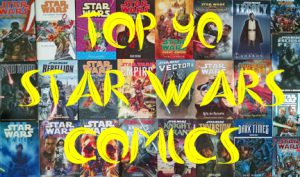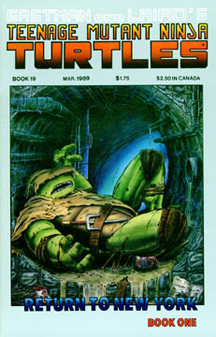By March 1989, Mirage “Teenage Mutant Ninja Turtles” Volume 1 had built up 1 ½ years of anticipation since the Foot Clan burned down April’s building and the Turtles fled to Casey’s rural Northampton farm. A wait like that is both good and bad: People were no doubt snatching up Issues 19-21 (“Return to New York,” Books One through Three), but the bar of anticipation was set incredibly high. In my estimation, Eastman and Laird made a successful return, but not a mindblowing one.
Understated and stylish
Although it sputters a bit in Book Three, “Return to New York” is mostly a fine piece of understated writing that pays off in all the ways readers expected. It’s also the most consistently stylish work up to this point, starting with the outstanding opening spread in Book One (also the cover image) of Raph sprawled in a sewer tunnel on a pile of newspapers.
They use that motif to flash back to a newspaper dated a few days earlier, when Raph is champing at the bit to go back to the Big Apple and kick some Foot and Saki butt. Leo thinks they’re not quite ready yet.

“Teenage Mutant Ninja Turtles” Issues 19-21 (1989)
Titles: “Return to New York, Book One” (No. 19), “Book Two” (No. 20), “Book Three” (No. 21)
Writers: Kevin Eastman and Peter Laird
Pencils: Kevin Eastman, Peter Laird, Jim Lawson
Inks: Kevin Eastman, Peter Laird, Eric Talbot
They fight (and penciller Jim Lawson firmly joins the fold as a master drawer of Turtle action), and Raph storms out, telling Mike “Don’t even think about” stopping him. Interestingly, Raph seems motivated by revenge, while Leo’s motivations are enigmatic.
The Turtles are still teenagers at this point, and not the most altruistic superheroes ever devised. No doubt all four of them want revenge. Probably Splinter does, too, although he and April and Casey don’t appear at all in “Return to New York.” (Presumably, the Turtles split for the city without telling Casey, because there’s no way he’d voluntarily sit this one out.)
Strange trouble afoot
What goes unstated is that the Foot Clan are a serious menace to society, and the Turtles should take it on if they’re truly devoted to stamping out crime wherever they find it, as they decided during the mouser crisis back in Issue 2.
Indeed, after Leo, Mike and Don catch up with Raph – now teamed up with the crazy Triceraton Zog — back at the ol’ sewer lair in Book Two, they learn that the Foot have taken over the entire Hudson Block, having hollowed it out into Foot Clan Headquarters. Foot soldiers also use the sewers to move through the city unseen.
Subtlety is all well and good, but I have to say it’s odd that the Mirage comics – at least up to this point – haven’t made it clear what exactly the Foot Clan does. The 1990 movie did a nice job of showing us how the clan uses their ninja skills to steal goods to build their crime syndicate, so I gotta assume they do some stuff along those lines. But owning and controlling an entire block of the city seems like it would require collaboration with a substantial chunk of corrupt city officialdom.

At any rate, that’s not relevant to “Return to New York” any more than Splinter, April and Casey are (even though Splinter arguably started – or at least re-started — this whole mess by sending his Turtles after Saki in Issue 1). Stopping crime is all well and good, but right now, the Turtles just want to kill Oroku Saki, and E&L have no intention of overloading this story with anything remotely superfluous.
Climactic spectacle
While Book One has the Leo-Raph rivalry and Book Two has Zog’s antics and the infiltration of Foot HQ, Book Three is even more streamlined. It mostly gets by on the spectacle of a Leo vs. Shredder fight scene and the blowing up of the Hudson Block (via overflowing water tank) by the other Turtles. Raph wanted desperately to take out the Shredder, but Leo gets to do it – will that lead to more resentment in future issues, or has Raph embraced the idea of being a team player?
The explanation of how Saki returned to life (worms, and a mix of magic and science) is absurd, and the three misshapen Shredders that the Turtles first encounter are sort of like the failed clone Ripleys in “Alien Resurrection.” Granted, probably zero fans had “worms” in the “How is the Shredder still alive?” pool, so it gets points for originality, but I’m not crazy about it. I would’ve liked another page or so of explanation (even if it would be pseudoscientific) rather than having Saki tell Leonardo in dialogue.
(Still, arguably, “worms” is better than the “TMNT II” explanation, which is that the Shredder simply survived getting crushed in a trash compactor, with only a scratched face to show for his troubles. Then again, there was no thermite bomb in in the movie saga, so what it lacks in cleverness, it makes up for in plausibility.)
But the bottom line is that the Shredder is finally dead, putting a period on this chapter of the Turtles’ lives as firmly as the katana with Saki’s helmet pinned into the ground. The fact of his final defeat is satisfying. But it also put the Mirage saga in the challenging position of needing new villains – after all, any writer will tell you that heroes are only as interesting as the villains they must overcome.
Eastman and Laird’s solution is to defer the challenge and hand over the saga to guest authors for three years …

